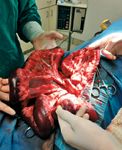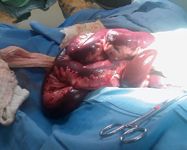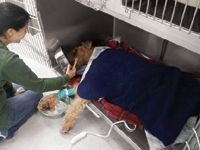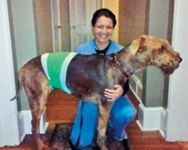5 lessons I learned from my pet's emergency
My pet's emergency changed my perspective on the questions clients ask-and how I respond.
We all know the drill. A pet comes in for emergency surgery. Your team gives the pet owner the lowdown on diagnosis, prognosis, and recovery expectations. You explain they'll be notified when Fido is in recovery. The client signs the consent form for surgery in a shaky hand and leaves. Several hours later you call the owner to say Fido is in recovery. The owners ask questions—questions you already answered before the surgery. You calmly repeat the answers and let them know when Fido can go home.

Julie Mullins, a veterinary assistant and staff training coordinator at Seaside Animal Care in ÂCalabash, N.C., poses with her furry friend, a 5-year-old Airedale terrier named Jack. (Photos courtesy of Julie Mullins and Dr. Ernie Ward)
The discharge day arrives and you take the owners into an exam room for the doctor to review surgery and care and for you to highlight discharge instructions. The owners ask the same questions again. You're so frustrated, you have to leave the exam room. You say to one of your co-workers, "They haven't listened to anything we told them. They just asked the doctor the very same questions they asked me. The same ones they asked him on the day of surgery."
The clients ask the same questions again in several follow-up calls post-operatively. You begin to ask yourself, "Am I communicating clearly enough? Maybe somebody else should speak to them."
I've been through the same frustrations. But I recently had an "aha" moment born out of my own pet's emergency surgery.
Jack, my shadow
Jack is a 5-year-old—and up till recently—97-pound lean chow hound of an Airedale terrier. He's my shadow, greeting me every morning before my feet hit the floor. One a particular Thursday a while back, I got ready without my shadow. Odd. I had to call him down to the kitchen for breakfast. When he arrived, he moved gingerly into the kitchen, head and tail down. He looked at his food and moved on by. I turned to my husband and said, "He's coming to work with me."
I work at Seaside Animal Care in Calabash, N.C., as a veterinary assistant and staff training coordinator. I've worked there for five years and pride myself on the knowledge I've gleaned working under exceptional doctors.
I took Jack in for some blood work and radiographs recommended by Dr. Jennifer Bailey. There was nothing untoward about either, so I took him home. He continued to have no appetite and vomited up water. So the following day—my day off—was spent doing a barium contrast study. He just lay there, and the questions began. They were questions I knew the answers to, yet I still asked them: "How long will we wait before we proceed to the next step? Will he end up in surgery?" Dr. Bailey and Dr. Eliza Roland were patient, answering my questions repeatedly.
The barium study revealed nothing obvious, so we went home again, hoping to see some barium stool overnight. That didn't happen, and Jack continued to decline.

Jack demonstrates his typical greeting.
Saturday morning—another day off—I was back at work for one more radiograph. The consulting doctors recommended exploratory surgery. I helped prep, sedate, and set up my beautiful, weak buddy in surgery. One of my co-workers, Angie, volunteered to be the surgical assistant for the procedure, and I felt incredibly grateful. Dr. Ernie Ward began the surgery at 9:07 a.m. and quite rapidly discovered and removed the obstructing wad of cotton. He began to inspect Jack's intestines, and he called me into the surgical suite. In a somber voice, he said, "Julie, I will need to take out about 3 feet of his intestines."
"Give me a number," I said.

Dr. Ward begins his extensive surgery to determine the cause of Jackâs illness.
"50/50," he replied.
I told him to go ahead. He inspected the intestines further and determined that it was not in fact 3 feet that needed to be removed. It was much more. He called me back in again to break the news, to show me why he needed to remove more and to get the go-ahead.
He began to remove the intestines, and my mind swam with questions and fears. I called my husband to relay the information about our furry son. He asked a question I couldn't answer: "Is he going to make it?"
Three hours later, Dr. Ward finished the final suture on his beautiful—albeit huge—incision site. Jack was in recovery, and I measured out the almost 10 feet of resected intestine.
Dr. Ward went over his prognosis. Grave. He discussed the importance of introducing food slowly when he woke, the importance of monitoring temperature, and the risk of infection. I'm sure he said more, but I didn't hear. I was busy recounting the times we'd gone for early morning runs and wondering if we'd ever do that again.

Dr. Ward indicates how much of Jackâs damaged intestines need to be removed.
The initial recovery went well. When when his daddy arrived, Jack opened his eyes and ate a therapeutic diet slurry—a diet mixed with water to make it drinkable. He even lifted his head. It was the first thing he'd eaten in three days. Our boy was back. He was walking around less than an hour later, went outside and had a soft bowel movement, and got busy healing. We were elated.
Sunday morning Jack began having loose stool. Explosive loose stool. His weight continued to drop, and a seroma—a pocket of clear, serous fluid that sometimes occurs in the body after surgery—developed that would gush blood when he walked. He continued on intravenous fluids and antibiotics and rested in the hospital. His appetite waxed and waned, but overall he seemed good.

Dr. Ward begins the excision of Jackâs intestines.
For the love of fur
Monday morning I went back to work and a brutal reality. Jack had felt well enough to chew out his catheter on Sunday night. He was transitioned to oral antibiotics and ate small meals every few hours. Every 15 minutes he experienced the worst kind of explosive diarrhea. He was leaking feces, and it dribbled down his legs when he walked. My head spun. I couldn't have him home like this. How long would it last? Would it ever stop? What could we do? I had to put aside these questions until the end of the day, when I could be the client, and not a technician. I knew the answers—but I needed to ask anyway.
It was at this moment my husband arrived to visit and take Jack outside. When he saw Jack, he asked me questions, and I had to answer calmly and with compassion. I told him that I didn't know. Jack's condition would likely improve, but by how much I couldn't say. Jack wasn't out of the woods yet.
At the end of the day, I asked these same questions of Dr. Ward. He told me calmly and with compassion that he didn't know for sure. Jack wasn't out of the woods yet. It was up to Jack's body to heal and see if the intestines that were left could learn how to do the job of what was lost. He reminded me that it had only been 48 hours since the surgery, and I needed to give it time.
Maybe it's a result of our instant lifestyle—e-mails that traverse the globe in seconds, microwave popcorn, fast food—that we expect instant results. I think more likely, though, that when a beloved pet is ill, the seconds drag on because of the sheer size of our love. Whatever the reason, time seemed to be the hardest thing to face.
Well, time, and Jack's fur.
How many times have you scoffed—of course, not in front of them—at clients who don't want to shave off their pet's fur for the sake of a medical procedure? It's just fur, right?
Jack was leaking liquid stool. Constantly. Leaking with intermittent blowouts. We were rinsing his backside and his legs, but the fur wasn't able to dry before he was leaking all over again. His caregivers suggested we shave his fur off. He had magnificent feathers on his legs. He was a powerful, majestic, enormous Airedale terrier. Shave his legs? I hadn't seen his legs since puppyhood! I knew it needed to be done for the sake of his red, irritated skin, but I still asked: "Do you think we really need to do that?"
With tears in my eyes and a lump in my throat, I shaved off my baby's beautiful fur. But I did stop short when it was time to clip the fur from his face. I couldn't do it. I'd continue to wash the filth off his face. He could have a little therapeutic diet slurry face. That fur, the way he looks, is part of what makes Jack, Jack.
Time to heal

"Jackâs damaged intestine," Mullins says. "Itâs an image I wonât soon forget."
The following days he began to be able to hold his stool until he got outside. While still liquid, the accidents were far less. His seroma was leaking less. It was time to go home.
I called Dr. Ward again and asked the same questions I'd asked him and the other three doctors at our practice for the last several days. Calmly and with compassion, he answered each one again.
Jack continued to have liquid stool and he continued to lose weight. His weight bottomed out at 82 pounds. His diet was radically altered. Before the surgery, he ate two cups of a high-protein diet. Now he needed to eat two cups of a low-fat diet five to six times daily. But over time, he continued to improve, and his diet changed to six to eight cups of the low-fat diet. My questions became less and less frequent. His recovery is going well.

"I had seen seromas before, yet this seemed somehow much larger on my own dog," Mullins says.
When I think back over this experience, I can see that I learned some huge lessons I hope to pass on. And I hope no one has to learn these lessons the way I did.
1. Love really does make you blind—and deaf. I learned firsthand that we need to speak slowly and clearly to our clients. When we're discussing major procedures we need to ask at regular intervals if they understand. I was used to medical jargon and still had questions about treatment. So how much more often do our clients, who have no medical background, have questions? We need to make sure they're listening and not taking trips down memory lane when we're explaining details about a pet's recovery.

Jack eats his first meals in days, immediately post-op. "I was so happy," Mullins says.
2. We need to give our clients time. We can't expect to be finished with a conversation in 30 seconds. This is a traumatic experience, and we need to remember to relate with empathy and compassion.

Jack, pictured before his illness.
3. Expect the "instant lifestyle" effect and remind clients that time heals. They need to remember how short a time it's been since their pet underwent a procedure and maintain realistic expectations for daily recovery.

Jack smiling, only a day after surgery.
4. Respect the fur when we can. It's more than just a covering. It's what makes their pet unique. When removal is warranted, build a case for it with understanding and compassion. Support clients as we remove their pet's personality. It does grow back. And who knows? They may grow to love the shorn look.

Jack, after his shaving.
5. Never forget the bond. When their pet hurts, they hurt. Our clients aren't trying to frustrate us. They require support from the humans sworn to care for their pets.

Jack at home, without some of his fur.
Jack had surgery Nov. 28, 2011. His weight plummeted to 82 pounds. Today, he is a healthy 90.4 pounds. Not long ago, we went for a morning run. We're coming out the other side with a new perspective.
Julie Mullins is a veterinary assistant and staff training coordinator at Seaside Animal Care in Calabash, N.C.